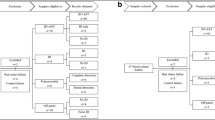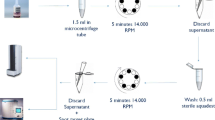Abstract
The rapid identification and antimicrobial susceptibility testing (AST) of bacteria in clinical blood cultures is crucial to optimise antimicrobial therapy. A previous study involving small sample numbers revealed that the addition of saponin to blood cultures, further referred to as the new method, shortened considerably the turn-around time for the identification and AST of Gram-positive cocci as compared to the current method involving an overnight subculture. Here, we extend previous results and compare the identification and AST of blood cultures containing Gram-negative bacilli by the new and current methods. The identification and AST of 121 Gram-positive and 109 Gram-negative bacteria in clinical monomicrobial blood cultures by the new and current methods and, in the case of Gram-negative bacilli, by direct (no additions) inoculation into an automated system (rapid method) was assessed using the Vitek 2 system. Discrepancies between the results obtained with the different methods were solved by manual methods. The new method correctly identified 88 % of Gram-positive and 98 % of Gram-negative bacteria, and the rapid method correctly identified 94 % of Gram-negative bacteria. The AST for all antimicrobials by the new method were concordant with the current method for 55 % and correct for an additional 9 % of Gram-positive bacteria, and concordant with the current method for 62 % and correct for an additional 21 % of Gram-negative bacilli. The AST by the rapid method was concordant with the current method for 62 % and correct for an additional 12 % of Gram-negative bacilli. Together, saponin-treated monomicrobial blood cultures allow rapid and reliable identification and AST of Gram-positive and Gram-negative bacteria.
Similar content being viewed by others
References
Bearman GML, Wenzel RP (2005) Bacteremias: a leading cause of death. Arch Med Res 36:646–659. doi:10.1016/j.arcmed.2005.02.005
Martin GS, Mannino DM, Eaton S, Moss M (2003) The epidemiology of sepsis in the United States from 1979 through 2000. N Engl J Med 348:1546–1554
Ibrahim EH, Sherman G, Ward S, Fraser VJ, Kollef MH (2000) The influence of inadequate antimicrobial treatment of bloodstream infections on patient outcomes in the ICU setting. Chest 118:146–155
Doern GV, Vautour R, Gaudet M, Levy B (1994) Clinical impact of rapid in vitro susceptibility testing and bacterial identification. J Clin Microbiol 32:1757–1762
Barenfanger J, Drake C, Kacich G (1999) Clinical and financial benefits of rapid bacterial identification and antimicrobial susceptibility testing. J Clin Microbiol 37:1415–1418
Hrabák J, Studentová V, Walková R, Zemlicková H, Jakubu V, Chudácková E, Gniadkowski M, Pfeifer Y, Perry JD, Wilkinson K, Bergerová T (2012) Detection of NDM-1, VIM-1, KPC, OXA-48, and OXA-162 carbapenemases by matrix-assisted laser desorption ionization-time of flight mass spectrometry. J Clin Microbiol 50:2441–2443. doi:10.1128/JCM.01002-12
Sparbier K, Schubert S, Weller U, Boogen C, Kostrzewa M (2012) Matrix-assisted laser desorption ionization-time of flight mass spectrometry-based functional assay for rapid detection of resistance against β-lactam antibiotics. J Clin Microbiol 50:927–937. doi:10.1128/JCM.05737-11
Hooff GP, van Kampen JJ, Meesters RJ, van Belkum A, Goessens WH, Luider TM (2012) Characterization of β-lactamase enzyme activity in bacterial lysates using MALDI-mass spectrometry. J Proteome Res 11:79–84. doi:10.1021/pr200858r
Bruins MJ, Bloembergen P, Ruijs GJ, Wolfhagen MJ (2004) Identification and susceptibility testing of Enterobacteriaceae and Pseudomonas aeruginosa by direct inoculation from positive BACTEC blood culture bottles into Vitek 2. J Clin Microbiol 42:7–11. doi:10.1128/JCM.42.1.7-11.2004
Chen J-R, Lee S-Y, Yang BH, Lu JJ (2008) Rapid identification and susceptibility testing using the Vitek 2 system using culture fluids from positive BacT/Alert blood cultures. J Microbiol Immunol Infect 41:259–264
de Cueto M, Ceballos E, Martinez-Martinez L, Perea EJ, Pascual A (2004) Use of positive blood cultures for direct identification and susceptibility testing with the Vitek 2 system. J Clin Microbiol 42:3734–3738. doi:10.1128/JCM.42.8.3734-3738.2004
Fontanals D, Salceda F, Hernández J, Sanfeliu I, Torra M (2002) Evaluation of wider system for direct identification and antimicrobial susceptibility testing of gram-negative bacilli from positive blood culture bottles. Eur J Clin Microbiol Infect Dis 21:693–695. doi:10.1007/s10096-002-0791-4
Funke G, Funke-Kissling P (2004) Use of the BD Phoenix Automated Microbiology System for direct identification and susceptibility testing of gram-negative rods from positive blood cultures in a three-phase trial. J Clin Microbiol 42:1466–1470. doi:10.1128/JCM.42.4.1466-1470.2004
Hansen DS, Jensen AG, Nørskov-Lauritsen N, Skov R, Bruun B (2002) Direct identification and susceptibility testing of enteric bacilli from positive blood cultures using Vitek (GNI+/GNS-GA). Clin Microbiol Infect 8:38–44. doi:10.1046/j.1469-0691.2002.00372.x
Ling TK, Liu ZK, Cheng AF (2003) Evaluation of the Vitek 2 system for rapid direct identification and susceptibility testing of gram-negative bacilli from positive blood cultures. J Clin Microbiol 41:4705–4707. doi:10.1128/JCM.41.10.4705-4707.2003
Waites KB, Brookings ES, Moser SA, Zimmer BL (1998) Direct susceptibility testing with positive BacT/Alert blood cultures by using MicroScan overnight and rapid panels. J Clin Microbiol 36:2052–2056
Waites KB, Brookings ES, Moser SA, Zimmer BL (1998) Direct bacterial identification from positive BacT/Alert blood cultures using MicroScan overnight and rapid panels. Diagn Microbiol Infect Dis 32:21–26. doi:10.1016/S0732-8893(98)00058-3
Munoz-Dávila MJ, Yagüe G, Albert M, García-Lucas T (2012) Comparative evaluation of Vitek 2 identification and susceptibility testing of Gram-negative rods directly and isolated from BacT/ALERT-positive blood culture bottles. Eur J Clin Microbiol Infect Dis 31:663–669. doi:10.1007/s10096-011-1356-1
Lupetti A, Barnini S, Castagna B, Capria AL, Nibbering PH (2010) Rapid identification and antimicrobial susceptibility profiling of Gram-positive cocci in blood cultures with the Vitek 2 system. Eur J Clin Microbiol Infect Dis 29:89–95. doi:10.1007/s10096-009-0825-2
Lupetti A, Barnini S, Castagna B, Nibbering PH, Campa M (2010) Rapid identification and antimicrobial susceptibility testing of Gram-positive cocci in blood cultures by direct inoculation into the BD Phoenix system. Clin Microbiol Infect 16:986–991. doi:10.1111/j.1469-0691.2009.03006.x
Clinical and Laboratory Standards Institute (CLSI) (2006) Methods for dilution antimicrobial susceptibility tests for bacteria that grow aerobically; approved standard—seventh edition. CLSI document M7-A7. CLSI, Wayne, PA
Clinical and Laboratory Standards Institute (CLSI) (2007) Performance standards for antimicrobial susceptibility testing; 17th informational supplement. CLSI document M100-S17. CLSI, Wayne, PA
Murray PR, Spizzo AW, Niles AC (1991) Clinical comparison of the recoveries of bloodstream pathogens in Septi-Chek brain heart infusion broth with saponin, Septi-Chek tryptic soy broth, and the isolator lysis-centrifugation system. J Clin Microbiol 29:901–905
Jorgensen JH (1993) Selection criteria for an antimicrobial susceptibility testing system. J Clin Microbiol 31:2841–2844
Christner M, Rohde H, Wolters M, Sobottka I, Wegscheider K, Aepfelbacher M (2010) Rapid identification of bacteria from positive blood culture bottles by use of matrix-assisted laser desorption-ionization time of flight mass spectrometry fingerprinting. J Clin Microbiol 48:1584–1591. doi:10.1128/JCM.01831-09
Ferroni A, Suarez S, Beretti JL, Dauphin B, Bille E, Meyer J, Bougnoux ME, Alanio A, Berche P, Nassif X (2010) Real-time identification of bacteria and Candida species in positive blood culture broths by matrix-assisted laser desorption ionization-time of flight mass spectrometry. J Clin Microbiol 48:1542–1548. doi:10.1128/JCM.02485-09
Prod’hom G, Bizzini A, Durussel C, Bille J, Greub G (2010) Matrix-assisted laser desorption ionization-time of flight mass spectrometry for direct bacterial identification from positive blood culture pellets. J Clin Microbiol 48:1481–1483. doi:10.1128/JCM.01780-09
Stevenson LG, Drake SK, Murray PR (2010) Rapid identification of bacteria in positive blood culture broths by matrix-assisted laser desorption ionization-time of flight mass spectrometry. J Clin Microbiol 48:444–447. doi:10.1128/JCM.01541-09
Peters RP, de Boer RF, Schuurman T, Gierveld S, Kooistra-Smid M, van Agtmael MA, Vandenbroucke-Grauls CM, Persoons MC, Savelkoul PH (2009) Streptococcus pneumoniae DNA load in blood as a marker of infection in patients with community-acquired pneumonia. J Clin Microbiol 47:3308–3312. doi:10.1128/JCM.01071-09
Kee C, Palladino S, Kay I, Pryce TM, Murray R, Rello J, Gallego M, Lujan M, Muñoz-Almagro C, Waterer GW (2008) Feasibility of real-time polymerase chain reaction in whole blood to identify Streptococcus pneumoniae in patients with community-acquired pneumonia. Diagn Microbiol Infect Dis 61:72–75. doi:10.1016/j.diagmicrobio.2007.12.011
Forrest GN, Roghmann MC, Toombs LS, Johnson JK, Weekes E, Lincalis DP, Venezia RA (2008) Peptide nucleic acid fluorescent in situ hybridization for hospital-acquired enterococcal bacteremia: delivering earlier effective antimicrobial therapy. Antimicrob Agents Chemother 52:3558–3563. doi:10.1128/AAC.00283-08
Stanley KK, Szewczuk E (2005) Multiplexed tandem PCR: gene profiling from small amounts of RNA using SYBR Green detection. Nucleic Acids Res 33:e180. doi:10.1093/nar/gni182
Lau A, Sorrell TC, Chen S, Stanley K, Iredell J, Halliday C (2008) Multiplex tandem PCR: a novel platform for rapid detection and identification of fungal pathogens from blood culture specimens. J Clin Microbiol 46:3021–3027. doi:10.1128/JCM.00689-08
Ellem J, Partridge SR, Iredell JR (2011) Efficient direct extended-spectrum β-lactamase detection by multiplex real-time PCR: accurate assignment of phenotype by use of a limited set of genetic markers. J Clin Microbiol 49:3074–3077. doi:10.1128/JCM.02647-10
Zong Z, Partridge SR, Thomas L, Iredell JR (2008) Dominance of bla CTX-M within an Australian extended-spectrum beta-lactamase gene pool. Antimicrob Agents Chemother 52:4198–4202. doi:10.1128/AAC.00107-08
Fishbain JT, Sinyavskiy O, Riederer K, Hujer AM, Bonomo RA (2012) Detection of extended-spectrum β-lactamase and Klebsiella pneumoniae carbapenemase genes directly from blood cultures by use of a nucleic acid microarray. J Clin Microbiol 50(9):2901–2904. doi:10.1128/JCM.01023-12
Acknowledgement
We wish to thank Dr. D. Angileri for his technical assistance.
Conflict of interest
All authors declare that they have no conflicts of interest.
Author information
Authors and Affiliations
Corresponding author
Rights and permissions
About this article
Cite this article
Lupetti, A., Barnini, S., Morici, P. et al. Saponin promotes rapid identification and antimicrobial susceptibility profiling of Gram-positive and Gram-negative bacteria in blood cultures with the Vitek 2 system. Eur J Clin Microbiol Infect Dis 32, 493–502 (2013). https://doi.org/10.1007/s10096-012-1762-z
Received:
Accepted:
Published:
Issue Date:
DOI: https://doi.org/10.1007/s10096-012-1762-z




